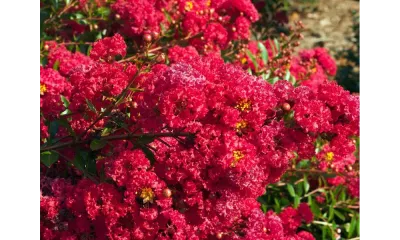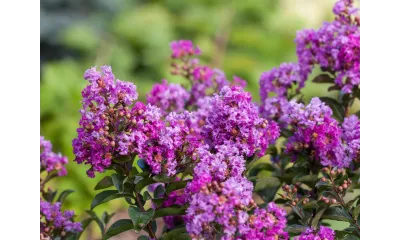
Crape Myrtle
Crape Myrtle
Crape Myrtles are summer flowering deciduous plants that range from 3 foot tall shrubs to large 20 foot tall (or taller) trees. Most varieties start flowering in June and will continue to provide color for 6-8 weeks throughout the summer. Depending on variety, flower color can be white, pink, purple, or red. The peeling bark of many varieties such as 'Natchez' add year-round interest. Many of the new varieties have dark purple foliage, which gives a unique appearance in the landscape. Crape Myrtles are a very versatile shrub that can be used as an accent tree or mixed with perennials in a flowerbed.
Planting
Plant Crape Myrtles in an area that receives full sun, 6 of more hours of direct light per day. Crape Myrtles need a well-drained soil, so choose a location that does not stay wet for too long. Dig hole twice as wide as root ball but no deeper. Remove from container and loosen the root ball to promote outward growth of the roots. Set Crape Myrtle in planting hole and back fill with soil that is 50/50 Pike Planting mix and native soil. Add Dr. Earth Root Zone organic starter fertilizer to help build the roots before you mulch with either pine straw or pine bark. The Root Zone will help decrease transplant shock and jumpstart root growth so the root system can establish quickly; the mulch will help keep the roots cool and conserve moisture.
Pruning
It is common practice to heavily prune Crape Myrtles early in the spring. This practice is not necessary and can be prevented by choosing a Crape Myrtle variety that fits your location. Crape Myrtles do benefit from some selective pruning, which you want to perform by pruning branches that are smaller in diameter than a pencil in February to help maintain the shape of the Crape Myrtle. Prune "suckers" anytime of the year, which usually come up from roots and can be unsightly. Finally, deadheading spent blooms will encourage more blooms well into the summer.
Care
• Most new varieties of Crape Myrtles are easy to care for as they are more disease resistant that older varieties. If you inherit a variety and are unsure of its disease resistance, inspect the foliage in late May for powdery mildew which presents as a white powder on the leaves and flower buds. Powdery mildew can be treated successfully using ____ fungicide throughout the summer. [waiting on product name from Buyer]
• Aphids can also be problematic as well. Look for small green insects in clusters on the underside of the leaves and new stems. Treat aphids with ____ insecticide in the late spring and watch for them throughout the summer. [waiting on product name from Buyer]
• Fertilize Crape Myrtles in March after the new growth has emerged with all-purpose Pike Nursery Landscape Fertilizer 14-7-7. Do not fertilize too heavily as it can limit the formation of flower buds, so make sure you follow the directions on the fertilizer bag or come speak to a Pike associate for advice.
• Water newly planted Crape Myrtles often to prevent stress while the roots are establishing. In the absence of rainfall, you'll need to water weekly for the first 2-3 months. Depending on location or time of year (like a hot, dry summer) new plants may need daily watering until they establish roots. In winter, when the plants are dormant, they'll need much less water. Established Crape Myrtles are waterwise and only need supplemental irrigation if the soil is very dry or if there is an extended period of drought. Water at the soil level using a soaker hose.

Razzle Dazzle Series
Dwarf shrubs that grow from 3-5' tall. Come in a variety of colors and are great for shrub and perennial beds.

Magic® Series
New series that vary in size and color. Some varieties have dark purple leaves that have a unique appearance.

U.S. National Selections
Varieties that were selected by the U.S. National Arboretum. 'Natchez' is the most popular selection which has pure white flowers and grows 30 feet tall - a multitrunked tree with spectacular cinnamon-colored bark on older trunks. 'Muskogee' has light lavender flowers and also reaches 30 feet tall. 'Tuscarora' reaches 15-20 feet tall and has hot coral pink flowers.



